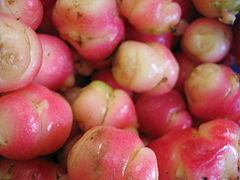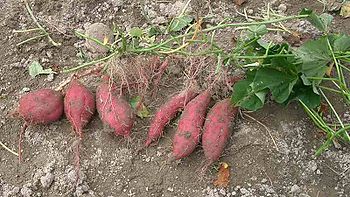- Tuber
-
- Tuber is Latin for "swelling", as also used for benign tumours such as in tuberous sclerosis
Tubers are various types of modified plant structures that are enlarged to store nutrients. They are used by plants to survive the winter or dry months and provide energy and nutrients for regrowth during the next growing season and they are a means of asexual reproduction.[1] There are both stem and root tubers.
Contents
Stem tubers
A stem tuber forms from thickened rhizomes or stolons. The tops or sides of the tuber produce shoots that grow into typical stems and leaves and the under sides produce roots. They tend to form at the sides of the parent plant and are most often located near the soil surface. The below-ground stem tuber is normally a short-lived storage and regenerative organ developing from a shoot that branches off a mature plant. The offspring or new tubers, are attached to a parent tuber or form at the end of a hypogeogenous rhizome. In the fall the plant dies except for the new offspring stem tubers which have one dominant bud, which in spring regrows a new shoot producing stems and leaves, in summer the tubers decay and new tubers begin to grow. Some plants also form smaller tubers and/or tubercules which act like seeds, producing small plants that resemble (in morphology and size) seedlings. Some stem tubers are long lived such as those of tuberous begonia but many tuberous plants have tubers that survive only until the plants have fully leafed out, at which point the tuber is reduced to a shriveled up husk.
Stem tubers generally start off as enlargements of the hypocotyl section of a seedling but also sometimes include the first node or two of the epicotyl and the upper section of the root. The stem tuber has a vertical orientation with one or a few vegetative buds on the top and fibrous roots produced on the bottom from a basal section, typically the stem tuber has an oblong rounded shape.
Tuberous begonia and Cyclamen are commonly grown stem tubers. Mignonette vine (Anredera cordifolia) produces aerial stem tubers on 12-to-25-foot-tall (3.7 to 7.6 m) vines, the tubers fall to the ground and grow. Plectranthus esculentus of the mint family Lamiaceae, produces tuberous under ground organs from the base of the stem, weighing up to 1.8 kg per tuber, forming from axillary buds producing short stolons that grow into tubers.[2]
Potatoes
Potatoes are stem tubers, which are the development of enlarged stolons thickened into a storage organ.[3][4][5]
The tuber has all the parts of a normal stem, including nodes and internodes, the nodes are the eyes and each has a leaf scar. The nodes or eyes are arranged around the tuber in a spiral fashion beginning on the end opposite the attachment point to the stolon. The terminal bud is produced at the farthest point away from the stolon attachment and tuber thus shows the same apical dominance of a normal stem. Internally a tuber is filled with starch stored in enlarged parenchyma like cells; also internally the tuber has the typical cell structures of any stem, including a pith, vascular zones and a cortex.
The tuber is produced in one growing season and used to perennialize the plant and as a means of propagation. When fall comes the above ground structure of the plant dies but the tubers survive over winter under ground until spring, when they regenerate new shoots which use the stored food in the tuber to grow. As the main shoot develops from the tuber, the base of the shoot close to the tuber produces adventitious roots and lateral buds on the shoot. The shoot also produces stolons that are long etiolated stems. The stolon elongates during long days with the presence of high auxins levels that prevent root growth off of the stolon. Before new tuber formation begins the stolon must be a certain age. The enzyme lipoxygenase makes a hormone, jasmonic acid, which is involved in the control of potato tuber development.
The stolons are easily recognized when potato plants are grown from seed, as the plants grow, stolons are produced around the soil surface from the nodes. The tubers form close to the soil surface and sometimes even on top of the ground. When potatoes are cultivated, the tubers are cut into pieces and planted much deeper into the soil. By planting the pieces deeper there is more area for the plants to generate the tubers and their size increases. The pieces sprout shoots that grow to the surface, these shoots are rhizome like and generate short stolons from the nodes while in the ground. When the shoots reach the soil surface they produce roots and shoots that grow into the green plant.
Root tubers
A tuberous root or storage root, is a modified lateral root, enlarged to function as a storage organ. The enlarged area of the root-tuber, or storage root, can be produced at the end or middle of a root or involve the entire root. It is thus different in origin but similar in function and appearance to a stem tuber. Examples of plants with notable tuberous roots include the sweet potato, cassava, yam and dahlia.
Root tubers are used to perennialize the plant, they store nutrients over periods when the plant can not actively grow, thus permitting survival from one year to the next. The thickened roots are storage organs that differ from stem tubers. The massive enlargement of secondary roots typically represented by Sweet Potato (Ipomoea batatas), have the internal and external cell and tissue structures of a normal root, they produce adventitious roots and stems which again produce adventitious roots.[6]
In root-tubers, there are no nodes and internodes or reduced leaves. Root tubers have one end called the proximal end, which is the end that was attached to the old plant; this end has crown tissue that produces buds which grow into new stems and foliage.[7] The other end of the root tuber is called the distal end, and it normally produces unmodified roots. In stem tubers the order is reversed, with the distal end producing stems. Tuberous roots are biennial in duration, the first year the plant produces root-tubers, and at the end of the growing season, the plant often dies except for the newly generated tubers. The next growing season, the root-tubers produce a new plant. As the shoot(s) of the new plant grow, the stored reserves of the root-tuber are consumed in the production of new roots, stems, and in flowering; any remaining root tissue dies concurrently to the plants regeneration of next generation of root-tubers.
Hemerocallis fulva plus a number of Daylily hybrids have large root-tubers, H. fulva spreads by underground stolons[8] that end with a new fan that grows roots that produce thick root tubers and then send out more stolons.[9][10]
Root tubers, along with other storage tissues that plants produce, are consumed by animals as a rich source of nutrients. The root-tubers of Arrowhead plants of the genus Sagittaria are eaten by ducks.[11]
Plants with root tubers are propagated in late summer to late winter by digging up the tubers and separating them, making sure that each piece has some crown tissue for replanting.
See also
- Bulb – modified stems with a short fleshy vertical stem, covered by thick fleshy modified leaves that enclose a bud for the next season's growth.[12]
- Corm – modified stems covered by dry scale-like leaves called a tunic, differing from true bulbs by having distinct nodes and internodes.
References
- ^ Rooting cuttings of tropical trees, London: Commonwealth Science Council, 1993, pp. 11, ISBN 978-0-85092-394-0
- ^ Organographic and anatomical evidence that the edible storage organs of Plectranthus esculentus N.E.Br. (Lamiaceae) are stem tubers Author(s) ALLEMANN J. ; ROBBERTSE P. J. ; HAMMES P. S. ;
- ^ Potato Genome Project
- ^ Interrelationships of the number of initial sprouts, stems, stolons [1] and tubers per potato plant Journal Potato Research. Springer Netherlands ISSN 0014-3065 (Print) 1871-4528 (Online)Issue Volume 33, Number 2 / June, 1990
- ^ http://www.personal.psu.edu/faculty/w/x/wxm15/Online/Botany/Stems/stem_lecture_01.htm
- ^ Davis, Edited by Tim D.; Haissig, Bruce E. (1994), Biology of adventitious root formation, New York: Plenum Press, pp. 17, ISBN 0306446278
- ^ Kyte, Lydiane; Kleyn, John (1996), Plants from test tubes : an introduction to micropropagation, Portland, Or.: Timber Press, pp. 23–24, ISBN 0881923613
- ^ http://www.efloras.org/florataxon.aspx?flora_id=2&taxon_id=200027676
- ^ Mansfeld, Rudolf (2001), Mansfeld's Encyclopedia of agricultural and horticultural crops, Berlin: Springe, pp. 2231, ISBN 3540410171
- ^ http://sain.utk.edu/invasives/species32.shtml
- ^ Hammerson, Geoffrey A. (2004), Connecticut wildlife : biodiversity, natural history, and conservation, Hanover: University Press of New England, pp. 89, ISBN 1584653698
- ^ Davis, P.H.; Cullen, J. (1979), The identification of flowering plant families, including a key to those native and cultivated in north temperate regions, Cambridge: Cambridge University Press, pp. 102, ISBN 0521293596
External links
- Cook's Thesaurus has a good inventory of tuber varieties.
Categories:- Plant morphology
- Plant reproduction
- Plant anatomy
- Tubers
Wikimedia Foundation. 2010.


